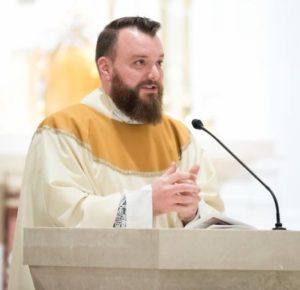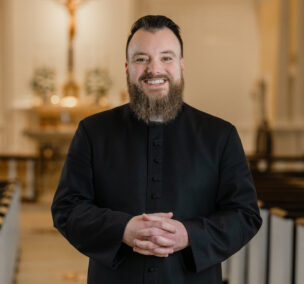 Dear Brothers and Sisters in Christ,
Dear Brothers and Sisters in Christ,
Though it may seem an unlikely connection, our celebration this Sunday of Mother’s Day bears a strong spiritual connection to the great feast of Pentecost and the whole life of the Church. Today we celebrate our mothers, the women who gave us the gift of life, the women who nurtured that gift in us, the women who by virtue of biology, spiritual relation, adoption, or personal influence have shown us the deeper meaning of our humanity. We honor our mothers and those women in our lives who have taken on a maternal role, both living and deceased. We understand that the bond with our mothers is especially strong, even if we have not always been fully aware of its import. This Thursday, we will mark the solemnity of the Ascension of the Lord and begin the great novena of Pentecost. In those nine days from the Ascension to the descent of the Holy Spirit, the Apostles devote themselves to prayer with the Blessed Virgin Mary. As Mother of Christ and Mother of all who follow Him, Mary guides and teaches the Apostles, helping them to prepare for the gift they are about to receive. On Pentecost the Holy Spirit falls upon them and they go out proclaiming the Gospel. That day is known as the birthday of the Church, that Church which in classical terms is called “mother.” The Church, like a mother, guides, guards, teaches, and feeds her children, those who like the Apostles have come to believe in and follow Jesus Christ. Those who follow Jesus, that is, those who make up the Church, are entrusted to the maternal care of Mary, the model of motherhood and true spiritual mother of us all.
In the month of May, the Church dedicates special attention to the Blessed Virgin Mary in prayer and devotion. As we celebrate our own mothers and the great Mother of Jesus, I offer you these words from Pope St. John Paul II’s encyclical Redemptoris Mater, in which he highlights the beauty of Mary’s relationship with the Church and with every Christian believer.
“Now, at the first dawn of the Church, at the beginning of the long journey through faith which began at Pentecost in Jerusalem, Mary was with all those who were the seed of the “new Israel.” She was present among them as an exceptional witness to the mystery of Christ. And the Church was assiduous in prayer together with her, and at the same time “contemplated her in the light of the Word made man.” It was always to be so. For when the Church “enters more intimately into the supreme mystery of the Incarnation,” she thinks of the Mother of Christ with profound reverence and devotion. Mary belongs indissolubly to the mystery of Christ, and she belongs also to the mystery of the Church from the beginning, from the day of the Church’s birth. At the basis of what the Church has been from the beginning, and of what she must continually become from generation to generation, in the midst of all the nations of the earth, we find the one “who believed that there would be a fulfillment of what was spoken to her from the Lord” (Lk. 1:45). It is precisely Mary’s faith which marks the beginning of the new and eternal Covenant of God with man in Jesus Christ; this heroic faith of hers “precedes” the apostolic witness of the Church, and ever remains in the Church’s heart hidden like a special heritage of God’s revelation. All those who from generation to generation accept the apostolic witness of the Church share in that mysterious inheritance, and in a sense share in Mary’s faith.
Elizabeth’s words “Blessed is she who believed” continue to accompany the Virgin also at Pentecost; they accompany her from age to age, wherever knowledge of Christ’s salvific mystery spreads, through the Church’s apostolic witness and service. Thus is fulfilled the prophecy of the Magnificat: “All generations will call me blessed; for he who is mighty has done great things for me, and holy is his name” (Lk. 1:48-49). For knowledge of the mystery of Christ leads us to bless his Mother, in the form of special veneration for the Theotokos. But this veneration always includes a blessing of her faith, for the Virgin of Nazareth became blessed above all through this faith, in accordance with Elizabeth’s words. Those who from generation to generation among the different peoples and nations of the earth accept with faith the mystery of Christ, the Incarnate Word and Redeemer of the world, not only turn with veneration to Mary and confidently have recourse to her as his Mother, but also seek in her faith support for their own. And it is precisely this lively sharing in Mary’s faith that determines her special place in the Church’s pilgrimage as the new People of God throughout the earth…
This presence of Mary finds many different expressions in our day, just as it did throughout the Church’s history. It also has a wide field of action. Through the faith and piety of individual believers; through the traditions of Christian families or “domestic churches,” of parish and missionary communities, religious institutes and dioceses; through the radiance and attraction of the great shrines where not only individuals or local groups, but sometimes whole nations and societies, even whole continents, seek to meet the Mother of the Lord, the one who is blessed because she believed is the first among believers and therefore became the Mother of Emmanuel. This is the message of the Land of Palestine, the spiritual homeland of all Christians because it was the homeland of the Savior of the world and of his Mother. This is the message of the many churches in Rome and throughout the world which have been raised up in the course of the centuries by the faith of Christians. This is the message of centers like Guadalupe, Lourdes, Fatima and the others situated in the various countries. Among them how could I fail to mention the one in my own native land, Jasna Gora? One could perhaps speak of a specific “geography” of faith and Marian devotion, which includes all these special places of pilgrimage where the People of God seek to meet the Mother of God in order to find, within the radius of the maternal presence of her “who believed,” a strengthening of their own faith. For in Mary’s faith, first at the Annunciation and then fully at the foot of the Cross, an interior space was reopened within humanity which the eternal Father can fill “with every spiritual blessing.” It is the space “of the new and eternal Covenant,” and it continues to exist in the Church, which in Christ is “a kind of sacrament or sign of intimate union with God, and of the unity of all mankind.”
In the faith which Mary professed at the Annunciation as the “handmaid of the Lord” and in which she constantly “precedes” the pilgrim People of God throughout the earth, the Church “strives energetically and constantly to bring all humanity…back to Christ its Head in the unity of his Spirit.”” (Redemptoris Mater 27-28)
May our mothers, like Mary, be a source of unity with Christ for their children. May we, as a community of believers gathered around Mary enter deeply into the novena of Pentecost so that, filled with the power of the Holy Spirit, we may be strengthened in our mission to proclaim the Gospel to all the world, to bring many souls to the shelter of our mother the Church, and in the end, to the unity that is found only in Christ.
Peace,

Fr. Sam


